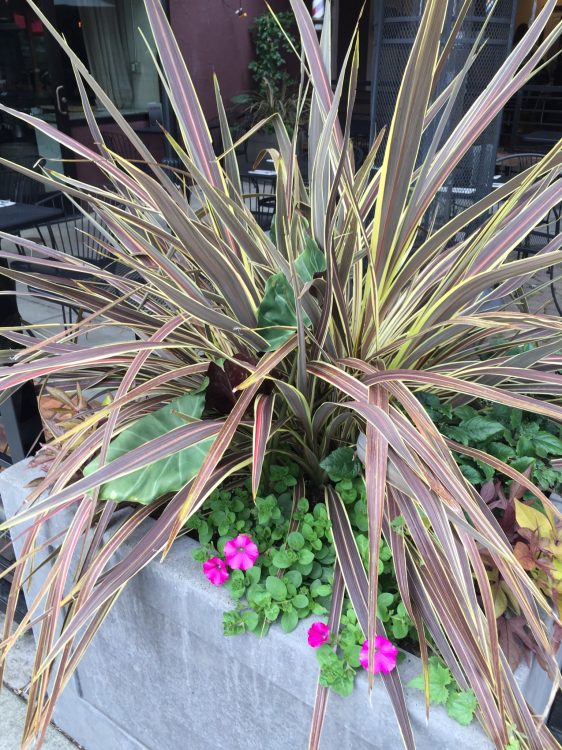 The Electric Star Bed
The Electric Star Bed
This bed takes its name from the giant Cordyline banksii ‘Electric Star’ that have overwintered and flourished here. Another newer introduction, ‘Electric Star’ is a tricolor that we have been impressed with. It blends with many other colors, but is also bold and robust; it’s bulked up quickly here in Edmonds. Also remaining from 2015 is the patch of Sedum nussbaumerianum. We’ve moved it to the opposite side of the bed. We planted this tender Sedum in late July, after we lost a batch of Lobelia ‘Hot Springs Lavender Pink’ in the mid-summer heatwave. This Coppertone Stonecrop adapted well here quickly and made it through winter freezes with minor damage.
Other succulents to note in this mixed planting are the Aeonium ‘Blushing Beauty’ and the Agave attenuata ‘Ray of Light.’ Aeonium ‘Blushing Beauty’ was one of our most impressive plants in the test garden last year. We’ve planted a large group here, which will swell to large flower-like heads well into late fall. We expect these Aeoniums to again outlast any annual color in this bed. We’ve also stocked the plaza with a host of other Aeoniums this year, as competition to ‘Blushing Beauty’s’ 2015 performance (read more about this Aeonium trial at the Sunburst bed).
Agave attenuata ‘Ray of Light’ was selected to show the range of this genus. These Fox Tail Agaves are a very delightful type of Agave to grow: they grow quickly in size, have soft leaves without spines, and have a light chalky (pruinose) coating on their leaves, which glows in certain light or when sprinkled with raindrops. Agave attenuata prefer some shade as well and are hardy to 25-30 degrees. The leaves of this variegated cultivar have bright cream edges, and often an errant stripe down the leaf center. Despite its little tolerance to cold, we feel that this is one of the most satisfying Agave to grow for three seasons of interest.
Other plants to note here are the Strelitzia reginae (aka Bird of Paradise) and the Kumquat ‘Meiwa’ planted near the center of the bed. We decide to put a few surprises here this season, with two plants typically thought of as houseplants. We don’t expect to see the Strelitzia bloom this year, but their large leaves will be a standout thriller in this bed. We have been big fans of Kumquat varieties for years, given their readiness to bloom and fruit densely, repeatedly over the course of a season. When it comes to citrus, we know that the Improved Meyer Lemon is still king, but we also feel it’s worth showing off Kumquats as other citrus options, which are often better looking and easier plants to grow.
Begonia ‘Morroco,’ Dianthus ‘Jolt Cherry,’ Coleus ‘Sedona,’ and Gerbera ‘Revolution Bicolor Mix’ are some the annuals we’ve chosen to highlight here. The Coleus will grow and bulk, acting as a vibrant copper-colored shrub in the bed, while the newly introduced Dianthus should bloom a month longer than any other barbatus type, with large, more vivid flower heads atop stronger stems.